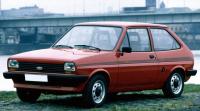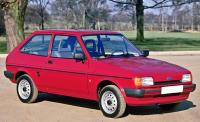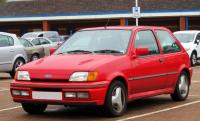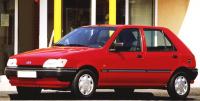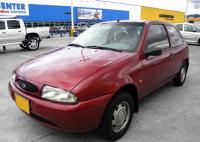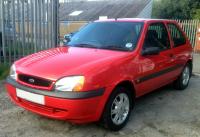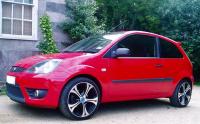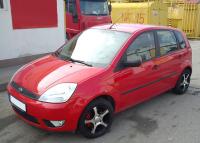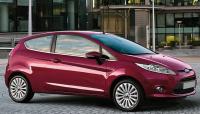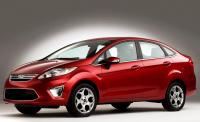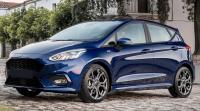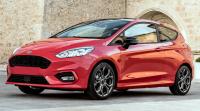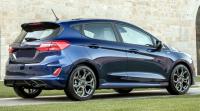First generation
The first generation Fiesta was produced with 1976 to 1983 years with 957 cc engines3 (40 HP) and 1117 cm3 (53 HP), located across the front compartment. The body was made in the form of a hatchback with 3 doors. Options in Europe - Base, Popular, L, GL (and since 1978 - Ghia and S). Options in the USA are Base, Decor, Sport and Ghia. All US trims came with a more powerful 1596cc3 engine. In 1981 Escort replaced the Fiesta in the US market.
Minor restyling was in 1981. The bumper was enlarged to comply with traffic regulations and other minor improvements to keep the focus ahead of the release of the second generation.
Second generation
Fiesta second generation came out in the middle 1983 year and produced until 1989 of the year. During this period, about 2 million units were produced. Automatic transmission appeared in 1985 on some trim levels. The engines remained the same as in the first generation with minor changes. For the first time, a 1600 cm3 diesel appeared, adapted from the Escort, and also in 1986 a 1400 cm3 injector appeared.
The appearance of the car has become more dynamic. The dashboard has become different on simple and more expensive trim levels.
Third generation
The third generation was introduced in late 1988, codenamed BE-13. This generation has been produced since February 1989 to 1997 years. The car is based on a new platform, and, most importantly, a 5-door hatchback model has appeared. The rear suspension became semi-independent, a four-channel ABS system, a traction force distribution system and emergency braking appeared. The volume of the diesel engine has been increased to 1800 cm3.
Since 1995, the car has been sold simultaneously with the fourth generation. To make the cars stand out, the finish of the car was revised and introduced to the market as the Fiesta Classic. This version was produced until 1997.
Fourth generation
New fourth generation Fiesta (codename BE91) produced from 1995 to 1999 years. The chassis of the car remains the same as the previous generation, but most of the components have been improved, including a new suspension, making the car one of the best in its class. The interior has also undergone significant changes, more expensive materials have been used. Body options remained the same - 3-door and 5-door hatchback.
Engines installed new 1250 cm3 (75 HP) and 1400 cm3 (90 HP) called Zetec-SE. The diesel engine was also updated a bit - they called Endura DE, but the volume remained the same - 1800 cm3 (60 HP).
Fourth generation (restyling)
This generation of Fiesta was produced from 1999 to 2002 years. These were mainly external changes aimed at a new look at cars - New Edge. New more powerful Zetec 1600cc3 16 valve engine added (103 HP). Environmentally friendly E-Diesel in 2001 and the new Lynx 1.8 TDDi diesel. There are new options, such as side airbags and leather trim.
Fifth generation
WITH 2002 to 2008 years produced cars of the fifth generation. This car was introduced April 1, 2002:) Most of the engines were carried over from the fourth generation and renamed Duratec. The line of gasoline engines began to include the following volumes - 1250, 1300, 1400, 1600 and 2000 cm3. There are two types of diesel engines - 8-valve 1400 cm3 and 16-valve Duratorq TDCi with a volume of 1600 cm3.
The line of trim and equipment is as follows - Finesse, LX, Zetec and Ghia. ABS and passenger airbags are also available as standard. Body options are available as in the previous generation - 3-door and 5-door hatchback. Slightly increased the wheelbase, which made the interior more spacious. Appearance is very different from the fourth generation.
In 2006, a restyling was carried out. These are mainly cosmetic changes - front and rear lights, bumpers, side moldings, rear-view mirrors, and a bright color palette has also been introduced. Inside, the dashboard has been redesigned, trimmed with soft-touch materials. New technologies have been applied such as electrically folding mirrors, automatic windshield wipers, trip computer, Bluetooth with voice control, MP3 player and electronic stability control.
Sixth generation
The sixth generation Fiesta was introduced at the Frankfurt Motor Show in September 2007 as the Ford Verve. Produced with 2008 years to the present. This model is based on the new Ford B3 platform for B-class cars. Body types are as follows - 3-door and 5-door hatchback, 4-door sedan and 3-door van.
The range of engines has been greatly expanded. Gasoline engines - 1000cc3 Ecoboost I3; 1200 cm3, 1400 cm3, 1500 cm3, 1600 cm3 Sigma I4; 1600 cm3 Ecoboost I4. Diesel - 1400 cm3 and 1600 cm3 DLD-416 I4. Transmissions are also presented in a wide range - 4-speed automatic, 5-speed and 6-speed mechanics, 6-speed PowerShift automatic.
The Fiesta is equipped with Ford's Convers+ menu system, the same as on Mondeo, C-MAX and Galaxy, and is complemented by steering wheel controls. Also, a keyless entry system and engine start with a button, a USB port for connecting music players.
Seventh generation
In November 2016, it was presented Fiesta 7, and in 2017 the production of this model began. Externally, the car has not changed very much, more like a deep restyling. The interior has become more refined, the quality of finishing materials has increased, the number of interior equipment has increased. Due to falling demand, the car will not be sold in America. In South America, they began to produce and sell the updated sixth generation.
The body shape is made in the form of a three- and five-door hatchback. Body length is 4048 mm, width 1735 mm, height 1490 mm, wheelbase 2493 mm and curb weight 1179 kg. In total, six trim levels were produced - Essential, Trend, ST-Line, Titanium, Vignale and Active. In September 2021, a restyled version was introduced. The grille became larger, the logo moved to its center, a 12.3-inch digital screen appeared on the dashboard, and diesel versions were discontinued.
Gasoline engines were installed only three-cylinder 1.0-liter (998 cm3, Ecoboost, turbo, 85/100/125 hp), 1.1 liters (1084 cm3, 70/85 hp) and 1.5 liters (1497 cm3, Ecoboost, turbocharged, 200 hp). Also, at first there was a diesel model with a 1.5-liter four-cylinder engine (1499 cm3, DLD-415, 85/120 hp). The transmission was a five- and six-speed manual, six-speed automatic or seven-speed robotic. In 2021, hybrid versions appeared.
